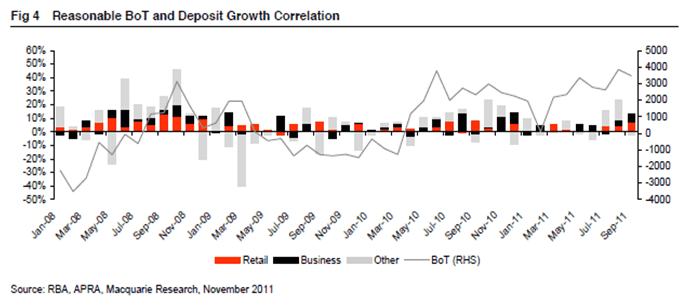
From Banking Day:
Household deposits continue to grow at a faster rate than home loans, according to the latest Australian Prudential Regulation Authority banking statistics.
This is good news for banks trying to increase the proportion of their funding coming from deposits.
Total household deposits grew by 8.3 per cent during the 12 months to April 2012. Over the three months to April, the growth dropped back to 1.7 per cent – an annualised rate of 6.8 per cent.
Total mortgage balances grew by 5.7 per cent over the 12 months to April and by an annualised rate of 5.2 per cent over the three months to April.
RaboDirect has had the biggest inflows, growing its book 60 per cent over 12 months and by three per cent just in the month of April.
Others that have grown above system in recent months include Investec, AMP Bank, ANZ and Suncorp.
Among those recording deposit outflows were Citibank (down eight per cent over the three months to April) and Rural Bank (down 7.2 per cent over the three months)
Among the big banks, all four have had deposit growth running well ahead of mortgage growth over the past year.
This is good and bad news. Good certainly that deposit growth continues ahead of mortgage growth, helping recalibrate bank funding exposures. But credit is broader than mortgages and all told ADI’s have assets in the vicinity of $2.8 trillion. Deposits are only $1.48 trillion so need to grow almost twice as fast as bank assets to be usefully shifting funding profiles.
So, the slowing of growth is a concern, though it is not unexpected.
The following chart from Macquarie Bank shows the possible correlation between the trade balance and deposit growth:

As you can see the correlation is strong between a trade surplus and deposit growth. And with the trade deficit falling deeply into deficit in January a slowing of deposit growth was a reasonable conclusion to draw. Later in the year, the trade deficit is likely to turn even more negative, suggesting deposit growth will slow further. That’s not great news for the economy or financial stability given that either:
a) rate cuts will stimulate borrowing just as deposits fall, forcing banks to borrow more offshore even as markets grow more suspicious of the wisdom of doing so, or
b) more likely, rate cuts will do nothing to stimulate new borrowing but deposit rates will still fall, unless folks save more, hurting demand in the process
We shall see.

